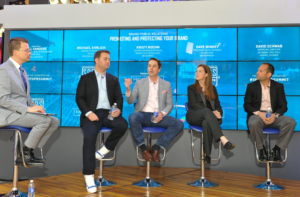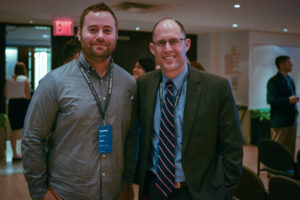7 Questions with adidas PR Director Michael Ehrlich
October 28, 2016

Michael Ehrlich is adidas’ PR Director. He started working for the company in 2013. Since then, the company’s stock and hold on the sneaker market have increased exponentially. We talked with Ehrlich to learn the tricks of the trade for successfully navigating such a fierce field of competition.
There’s not exactly a “typical” day for you, but how would you describe a typical day at work?
I love when people ask this question since two days are certainly never the same in the sports business and storytelling industries. For me personally, I’m an early riser so my workday technically starts well before I arrive to the office. The first thing I do in the morning is review the latest news cycle: what’s going on in sports, politics, culture and marketing across all brands. It really sets the tone for the rest of my day and helps contextualize any of our own stories that we plan to launch. My go-to source is of course Twitter, where I’m able to quickly catch up on what’s going on across the industry.
When I’m actually in the office (I travel quite a bit) I start my day there by diving into emails. With a Global Headquarters on the other side of the world, a lot of conversations are done via email and at atypical hours. My days at the office consist of planning meetings for upcoming product launches, editorial calendar reviews with my PR team, story syncing with our social strategy and community management counterparts, and of course communicating with media and garnering coverage of our stories.
Thankfully working across all sports and style categories for the brand, there really is no offseason for me. Two days are never the same and there aren’t many “slow” days at the office. I’m very lucky.
You’re really active on social platforms. How important is social media in the sports PR mix? What are your secrets for using social effectively?
The media landscape today continues to evolve, fusing traditional editorial means with real-time storytelling. Social is now at the root of everything PR related. It’s where media break stories, it’s where athletes interact with fans and it should be where PR professionals live, both to consume and understand media but also to activate their stories.
Having a presence on social is essential for PR leads today. In some instances, social is even the best place to communicate with your media targets, garner coverage and extend your brand stories.
Beyond leveraging platforms as PR tools, social offers you real-time feedback from your consumer. You’re able to get an instantaneous read on how your story hits, so it’s the ultimate focus group.

The athletes with whom adidas partners each have their own voice, which may or may not always be the same as the adidas message. How do you work with sponsored athletes to maintain consistent messages?
Media consumers, sports fans and kids today are more brand-aware than ever before, so it’s vital for athletes to speak in their own voice when promoting brand partners. Anything inauthentic – whether in a traditional on-camera interview or in a social media post – will raise flags with the public. Kids especially are so conscious of their own personal brands on social that they’ll see right through an athlete pushing a corporate message.
We work in unison with athlete partners on these storytelling opportunities; crafting messaging together via their own vernacular, using quotes directly from them in PR materials and empowering them to post brand messages on social in their voice.
In the athletic shoe and apparel industry, there’s always the possibility for crisis. How do you deal with crisis, and what advice would you give Sports PR professionals in crisis management?
Although I’m a proud USC alumnus, I subscribe to many John Wooden-isms, including “failing to prepare is preparing to fail.” At the first hint of a potential pending crisis, I recommend preparing as much as possible, as early as possible. That will not only help your communication process but perception-wise, your brand will look organized and calm in times of crisis. Whether that is alerting your executives as soon as you hear rumblings of a crisis or creating reactive communication plans or drafting messaging ahead of a story breaking, the more prep work you can do, the better.
If a crisis comes out of nowhere though, I wouldn’t rush to react or comment. Take the time to survey the narrative, take temperatures of your key stakeholders and calmly pull together an action plan with clear messaging. If you rush to comment on a crisis, you may add fuel to the fire, so be precise in your communicating planning and execution.
You work in a highly competitive market space up against companies such as Nike, Under Armour, Puma, and countless others. How can you use PR as a tool in differentiating your brand?
PR is such a powerful tool to differentiate your brand, no matter the industry or level of competition you face. Especially in today’s media landscape with the fusion of editorial and social, PR professionals now have unlimited access to storytelling opportunities, 24/7/365. Consequently, media receive so many story pitches a day, so it’s imperative for your content to stand out within their jam-packed inboxes. How you write copy, your content look and feel, the timing of when you share info or literally even how you share it, all ladders up to differentiating your brand via PR.
I continue to question if a press release is even needed or relevant across the landscape today. Trying new things, taking risks with your content and continuing to align your traditional PR and social media communication plans are paramount for breaking through in the crowded storytelling space.

You oversee U.S. PR for a global company. What are the challenges in that, and how do effectively manage the needs of your U.S. public while also staying consistent with the overall brand message?
As I mentioned earlier, the time difference between our Global HQ in Germany and our U.S. HQ in Portland is a challenge, but it’s not insurmountable. Thankfully, the brand overall has a clear communication strategy that extends across the globe and to each individual market. From a U.S. perspective, my team is empowered to plan and execute PR programs that are specifically designed for our consumers here, while still mirroring the overall global strategy.
Describe one situation that you handled especially well and are particularly proud of (either an event, a crisis, an announcement) – and what were the lessons from that experience?
Multi-tasking is key for any PR professional and it’s an aspect of my job that I take great pride in. Working across all sport and style categories, I’m constantly contributing to multiple projects at the same time. I love this pace and thrive in it, but without being able to manage my time and multitask, I’d be completely lost and ultimately the work would suffer.
Recently I was staffing a launch event in New York, coordinating executive interviews on a new product and spending quality time with my media friends when an exciting reactive storytelling moment for a different category popped up. I had to quickly pivot, get on the phone with some folks back at the office, finalize a content strategy and then seed the concept to media onsite and across the country. Again, using social as a go-to PR tool helped me quickly and successfully place this story with media in real-time.
A lesson from this experience is to consistently hone your multi-tasking skills so when you are in the heat of the moment – say at an event – you’re able to calmly and confidently tackle multiple tasks at the same time and successfully capitalize on a reactive storytelling opportunity.
###
